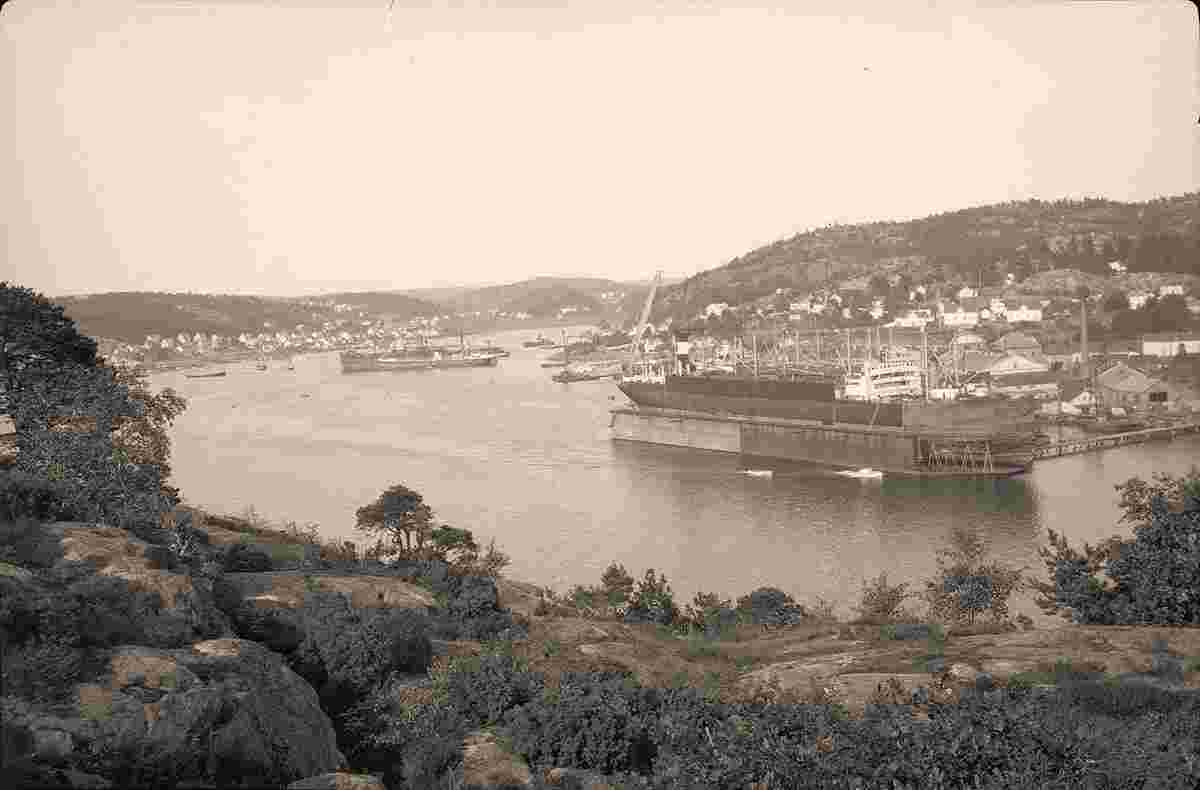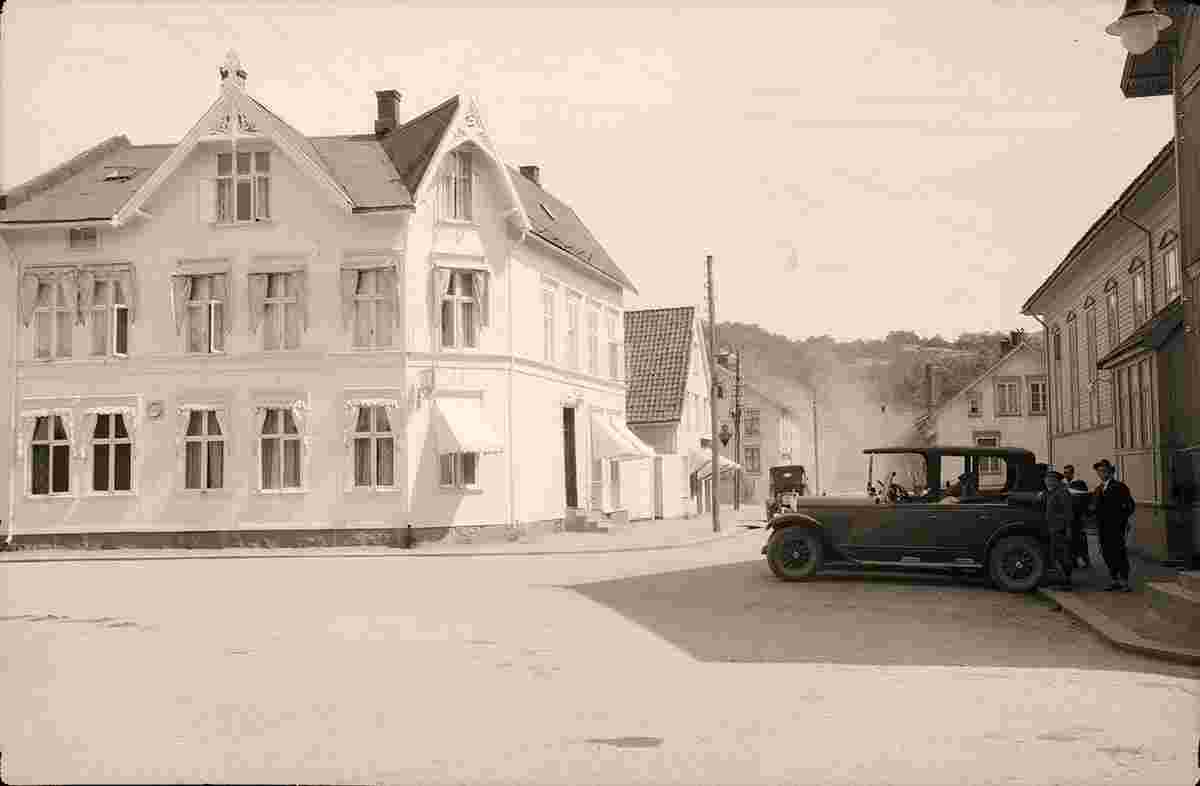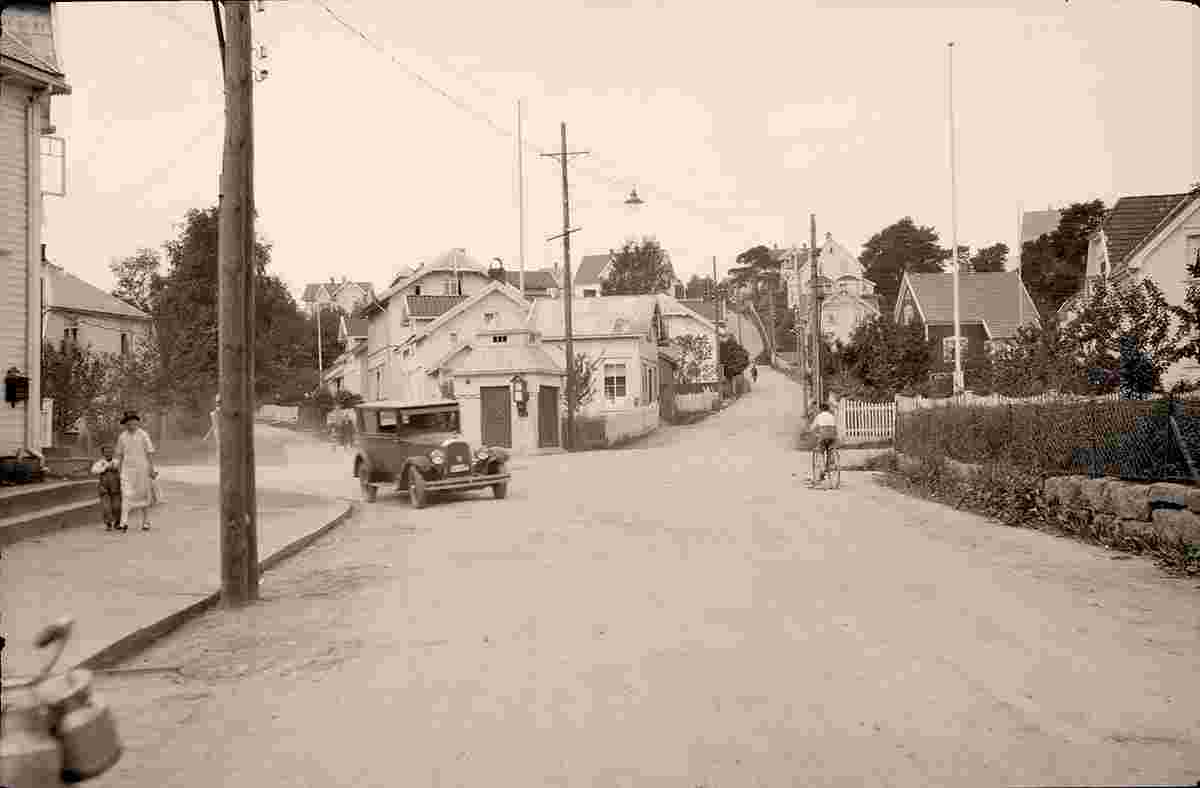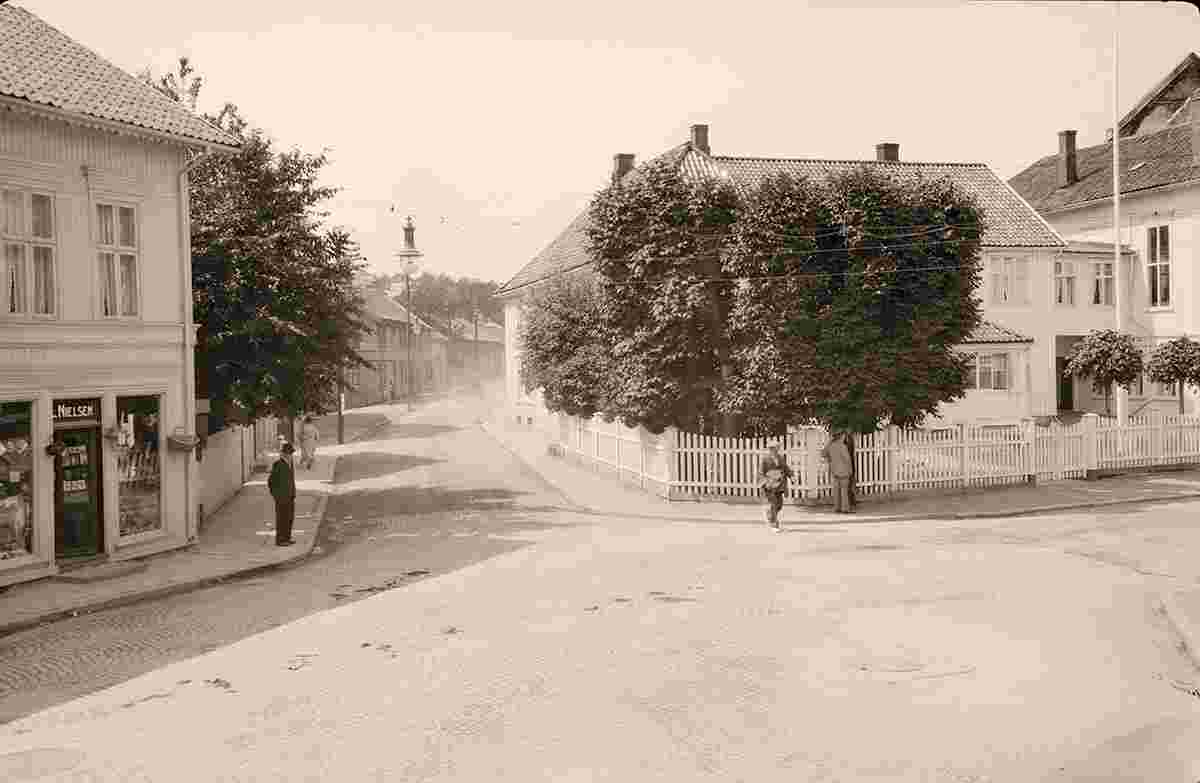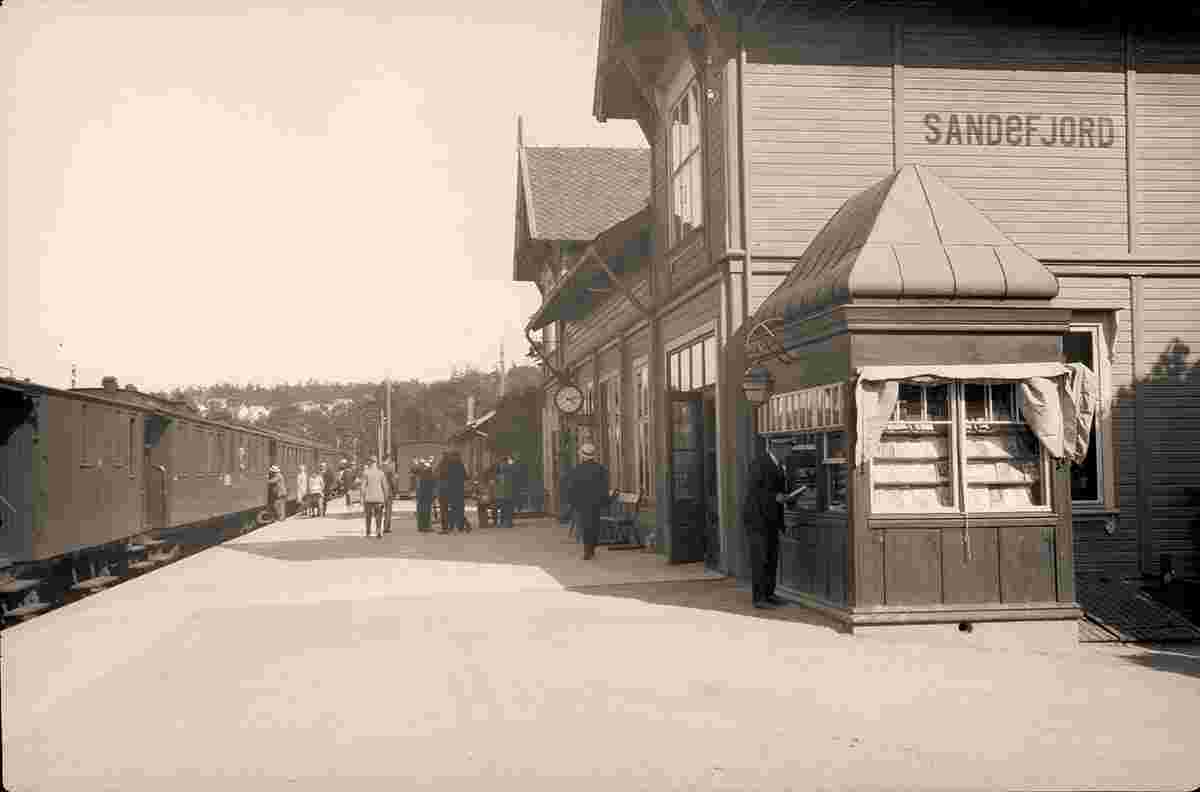Historical and old photos of Sandefjord, Vestfold and Telemark
HistoryViking historySandefjord has been inhabited for thousands of years. Excavations indicate that people have inhabited Sandefjord for around 3,000 years. Rock carvings at Haugen farm by Istrehågan in Jåberg are dated to 1,500–500 BCE. Haugen farm is home to Vestfold County's largest petroglyph site. The Vikings lived in Sandefjord and surrounding areas about 1,000 years ago, and numerous Viking artifacts and monuments can be found in Sandefjord. One of the most important remains from the Viking age was found at the grave site Gokstadhaugen (Gokstad Mound) in Sandefjord. The Gokstad ship was excavated by Nicolay Nicolaysen and is now in the Viking Ship Museum in Oslo. The Viking, an exact replica of the Gokstad ship, crossed the Atlantic Ocean from Bergen to be exhibited at the World's Columbian Exposition in Chicago in 1893. A replica of the Gokstad ship, called Gaia, currently has Sandefjord as home port. Other known replicas include the Munin, (a half scale replica) located in Vancouver, Canada. The Gokstad Ship, Norway's largest preserved Viking ship, was discovered during an excavation at Gokstad Mound in 1880. The Vikings first settled here due to its speedy route from Sandefjord and along the coast. Viking settlements and grave sites have been discovered in Sandefjord. Sandefjord functioned as a seaport defined by the twin industries of shipping and shipbuilding throughout the 1600s and 1700s. It was formally recognized as a market town by King Oscar in 1845. Its population at the time was 749 residents. Health resortThe city became known as a world-renowned health resort destination between 1837 and 1939. Royalty and Prime Ministers from throughout Europe visited the town for its spas in the late 1800s. The city gained its reputation as a health- and pleasure community when Sandefjord sulfur spa and resort ("Sandefjord Kurbad") was established in 1837. It was the first spa in town and functioned as a medical institution focusing on the treatment of symptoms for rheumatic diseases. The original bathhouse has been restored and is now a culture house by the city center. It was one of Europe's most visited baths until its closure in 1939. Around 50,000 people, mostly Norwegians, visited the bath from 1837 to 1939. Majority of spa visitors were from Norway, but international guests from Germany, Britain and the United States also visited the spas of Sandefjord. Today the bath's building, Kurbadet, has been restored and hosts cultural events and various annual activities. Town firesSandefjord has experienced numerous town fires, including a town fire in 1800 which led to most of the town burning down and subsequently having to be rebuilt. An additional fire in 1900 destroyed 56 houses and caused major damage. Whaling and shipsSandefjord is perhaps best known as a whaling community. The centre of the world's modern whaling industry was located in town, and Sandefjordians not only made up practically all the crew on the Norwegian whaling fleet, but substantial numbers of Sandefjordians also worked within the whaling industry in nearby countries. For over fifty years in the late 1800s, Sandefjord functioned as the world center for the whaling industry, including the manufacture and equipment of whaling vessels, floating factories, and whale-catchers. The city has also been named the "whaling capital of the world." From 1850, a number of ships from Sandefjord were whaling and sealing in the Arctic Ocean and along the coast of Finnmark. The first whaling expedition from Sandefjord to the Antarctic Ocean was sent in 1905. Towards the end of the 1920s, Sandefjord had a fleet of 15 factory ships and more than 90 whalers. In 1954, more than 2,800 men from the district were hired as crew on the whalers, but from the mid-1950s whaling was gradually reduced. The number of southbound expeditions rapidly decreased during the 1960s, and the 1967/68 season became the last for Sandefjord. The shipping industry was gradually readjusted from whaling to other ship types during this period. The local Framnæs Mekaniske Værksted and Jotun Group Private Ltd. had major roles in this business. Today, the memories of this important period of the city's history are kept alive at the Whaling Museum (Hvalfangstmuseet). This museum is the only museum in Europe specializing in whales and the history of whaling. The history of the whalers can also be explored at the Museum's Wharf with a visit aboard the whale-catcher Southern Actor. Whaling is considered to be the industry which made Sandefjord the richest city in Norway. Sandefjord also has shipping traditions of tall sailing ships and steam ships. The full rigged sailing ship Christian Radich, three-masted barquentine Endurance, whale catcher Jason and Viking ship replica Viking were some of the many ships built by Framnæs Mekaniske Værksted. Hans Albert Grøn of Sandefjord established the first whaling station in the Faroe Islands in 1894, which was located at Gjánoyri on the island of Streymoy. Furthermore, Sandefjord was the headquarters of the South African Whaling Company (SAWC), which was established in 1908 and managed by shipowner Johan Bryde of Sandefjord. Antarctic expeditionsTowards the beginning of World War I, Norwegian whaling spread throughout the world, most and foremost from Sandefjord. Expeditions from Sandefjord went as far as Norwegian Bay in Australia, Stewart Island in New Zealand, Walvis Bay in Namibia, Corral, Chile, and also isolated places such as Kerguelen Islands, South Georgia Island, Bouvet Island, and the Southern Ocean. In the 1910s, affluent Sandefjordian August F. Christensen was given a grant to practice whaling outside Peru and Ecuador. He was also appointed Ecuador's consul to Norway. He achieved an agreement with Ecuadorian government officials which allowed Norwegians to inhabit the Galápagos Islands, and also receive 200 hectares of land, pay no taxes for ten years, and be allowed to keep their Norwegian citizenship. Christensen created huge local interest of Galápagos, and the local company La Colonia de Floreana A/S was established on 21 March 1925. Its main goal was to exploit the Norwegian fishing rights at the Galápagos Islands. A ship named Floreana departed from Sandefjord on 15 May 1925, equipped with enough men and goods to establish a colony. On 16 November 1904, Carl Anton Larsen of Sandefjord established the whaling community of Grytviken, the largest settlement in South Georgia and the South Sandwich Islands. South Georgia Island lies a few thousand kilometers east of Cape Horn. Nils Larsen (1900–76) was a sea captain from Sandefjord, famous for his expeditions of Antarctica in the early 20th century. It was under his expeditions that Norway achieved annexation of Bouvet Island in 1927 and Peter I Island two years after. A cove on Antarctica's Peter I Island is named Sandefjord Cove in honor of Larsen's hometown. Sandefjord Ice Bay in continental Antarctica is also named after Sandefjord. Mount Nils Larsen in Queen Maud Land, Mount Nils in Enderby Land and Nils Larsen Glacier are examples of many geographical names given in honor of Nils Larsen. World War IIAt the beginning of the German occupation of Norway, a German Hafenkapitän (harbormaster) was placed at Tollboden, and a representative for Admiral Norwegen was placed in an office building at Framnes verft. German soldiers could be seen marching throughout the city. At the beginning of the occupation, over 2,000 German officers visited Socitetsbygningen (today's Park Hotel), which belonged to Sandefjord Spa. The Nazi flag was waving over the building during the visit. Norwegian students were told to learn the German language, and handed out a book, Deutsche Fibel. They were also given a copy of Adolf Hitler's book Mein Kampf translated into the Norwegian language. German forces constructed two coastal forts in Sandefjord, located at the southern tips of both West- and East Islands. A 120-meter tunnel was constructed at Folehavna Fort on Vesterøya, as well as four 15 cm canons installed in concrete gun pits on the sloping rocks. German construction also took place by Goksjø Lake, and also at Jernbaneallén, where a former garage structure was turned into a prison camp. Many Sandefjordians were killed during World War II, including a number of seamen. Håkon Andersen of Framnes was killed onboard Arcturus when the ship was attacked by British Beaufighters. Albert K. J. Skålsvik (1921–1944) of Krokemoa, a member of the Norwegian Homefleet ("Hjemmeflåten"), was 18 years when the war broke out. Skålsvik was killed, along with the captain, when the ship DS Kong Bjørn was attacked by allied warplanes by Ryvingen Lighthouse in 1944. He is now commemorated at the Hall of Remembrance in Stavern (Larvik). Skålsvik's younger brother, Bernard, was also a part of the Homefleet and was killed at age 17 in 1945. Radios were illegal, and Sandefjordians such as Henry Melby of Gokstad was arrested for having a radio in 1942. He was incarcerated at the tanker Inger Johanne, which was attacked by allied warplanes in 1944, killing 15 people, including Henry Melby. Following World War II, Norway became one of the founding members of NATO and several air bases were constructed in Norway using NATO funds. One of these was Sandefjord Airport Torp, which was to be used by the United States Air Force in case of war. Construction began in 1953 and was completed in July 1956. SAS mergeThe municipalities of Sandefjord (S), Andebu (A) and Stokke (S) merged on 1 January 2017. The merge was the first of numerous nationwide merges following a municipal reform by the Solberg Cabinet. The "new" municipality is 425.47 km2, including freshwater lakes and rivers. It is 11th most populated municipality in Norway, and the most populous in Vestfold County. Proposed names for the "new" municipality were Gokstad, Sandar and Torp, however, the name Sandefjord was ultimately kept. A poll conducted by Sandefjords blad in January 2015 called 600 residents in Andebu, 750 in Stokke, and 1,000 in Sandefjord. All were given the question "Do you think Stokke, Andebu, and Sandefjord should establish one single municipality?". 69% of Sandefjord residents answered "yes", while 64% (Andebu) and 61% (Stokke) answered "yes" in Stokke and Andebu. Few Stokke residents read Sandefjords Blad, the main newspaper of Sandefjord, and relatively few residents commute to Sandefjord proper for work. However, Sandefjord's wealth and its international airport have been seen as key factors as to why Stokke residents decided to merge. 77.8 percent of Stokke residents ultimately voted to merge into Sandefjord during the September 2015 elections. Origin: en.wikipedia.org | ||||||||||||
 |
Historical and old photos of Sandefjord, Vestfold and Telemark
Historiske og gamle bilder av Sandefjord, Vestfold og Telemark |
| Main page • Countries of Europa • Cities of Norway |
| Robinson Rd, CB 13862 Nassau, NP, The Bahamas |

